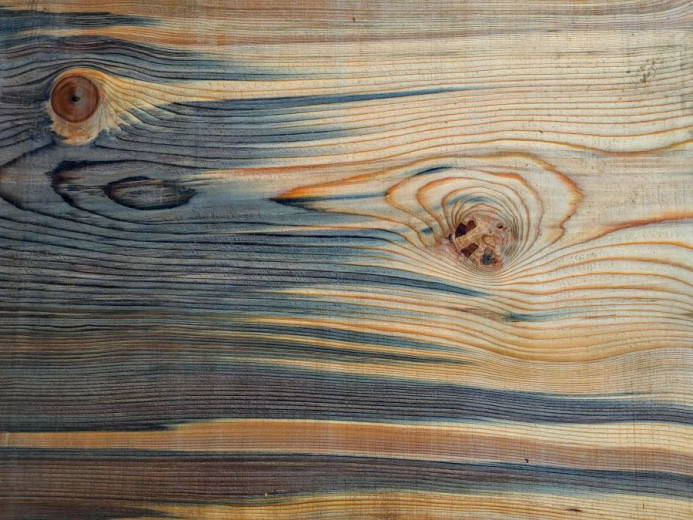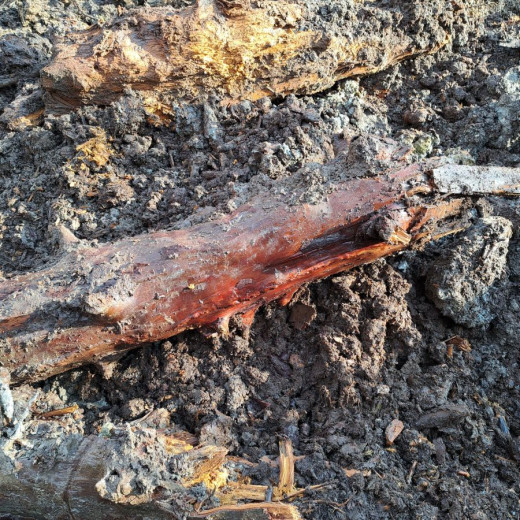Date: 3. February 2024
Time to read: 2 min
Forests are one of Slovenia's greatest natural treasures. So the discovery of a fir estimated to be roughly 6,500 years old in the village Čadrga is an exciting one.
Although this village in the Tolmin area has only 50 inhabitants, it was first mentioned in urbaria already in the 13th century. And if we look even further into the past, other interesting stories are revealed.
-
 The trunks were discovered by brothers Gorazd Kutin, nature protection warden in the Triglav National Park, and Jani Kutin, a farmer and woodworker. Due to their professions, they had the knowledge to recognise that the trunks were very old. Photo: Jani Kutin
The trunks were discovered by brothers Gorazd Kutin, nature protection warden in the Triglav National Park, and Jani Kutin, a farmer and woodworker. Due to their professions, they had the knowledge to recognise that the trunks were very old. Photo: Jani Kutin
-
 The age of the fir wood was confirmed by a C14 dendrochronological analysis conducted by a laboratory in Vienna. Photo: Gorazd and Jani Kutin
The age of the fir wood was confirmed by a C14 dendrochronological analysis conducted by a laboratory in Vienna. Photo: Gorazd and Jani Kutin
The restoration of ponds
Within the VrH Julijcev project, 15 livestock watering ponds were restored. Two of these ponds are near Čadrg.
When digging in the nearby woods to remove old sediment, leaves and branches from one of the ponds, the workers found old trunks about one and a half metres deep in the ground.
When dug out, the trunks turned grey. The change in colour was the first indication that the wood might be very old. Another reason for this assumption was that firs have not been present in this part of the Triglav National Park for at least 200 years. The collection of the Tolmin Museum includes an old fir wood chest which was made in Čadrg 300 hundred years ago.
Even before the discovery of the fir trunks, Čadrg was known for the find of Mesolithic hunters' stone tools, which are approximately 9,000 years old. Old pottery fragments were also found in this part of Slovenia. This find led archaeologists to the discovery of graves from the Early and Late Iron Ages. In addition to pottery, tools and jewellery were also found.
The surprising age of the firs
As the analysis at the Biotechnical Faculty in Ljubljana did not determine the age but only the type of wood (Abies alba or silver fir), a sample was sent to the Vienna Environmental Research Accelerator laboratory in Austria.
The laboratory determined that the wood sample was 6,560 years old.
The wood from this fir dates from about 4,536 BC. This means that the tree grew in the era of the Ljubljana Marshes' pile-dwellers.
The firs found in Čadrg probably fell in a storm. Because they were underwater and embedded in silt where there is no oxygen, they remained very well preserved.
There are very few fir specimens of a similar age anywhere in the world. A few pieces of fir wood were found in the Ljubljana Marshes, but they are only 2,000 or 3,000 years old and quite decayed. It is more common to find well preserved oak trees.
What to do with the wood?
Due to its great age, the experts will monitor the wood for some time. It is expected that when dry and kept at room temperature, it will no longer be at risk of decay. If deformations in the wood are not too great, it could be used to make something.
Will that be an instrument, a piece of furniture or something else? Two of the trunks are still intact.
It was proposed that at least one of them be buried again and thus preserved for future generations. A hundred years from now, when technology is more advanced, new information about the wood might come to light.











